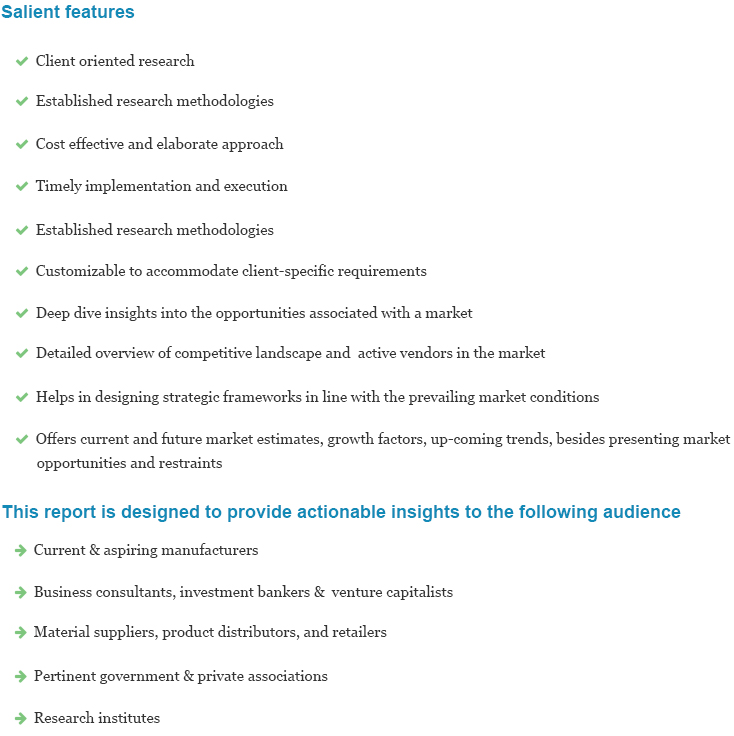
Smart Fitness Wear Market Size, Industry Analysis Report, Regional Outlook, Application Potential, Price Trend, Competitive Market Share & Forecast, 2016 To 2024
- Published: November, 2017
- Format: Electronic (PDF)
- Number of pages: 70
- Industry: Healthcare IT
The Smart fitness wear market is expected to grow at a CAGR of 30% over the forecast period from 2016 to 2024. Smart fitness wear are gaining popularity at a rapid pace. The major drivers identified for this growth are increasing demand for smart watches, smart wristbands, fitness & activity trackers, smart garments and clothing owing to surging consciousness regarding health and physical fitness, demand for technologically advanced products along with increasing need for innovative features and cost reduction of the key enabling technologies.
Surging demand for technologically advanced products with revolutionary features is prescribed to propel smart fitness wear market. Increasing usage of the products by athletes, trainers as a result of enhanced quality of workout, haptic alerts for workout regime driven the market consumption. Smart-textiles like t-shirt, leggings and socks are gaining popularity owing to accuracy of body workout on Smartphone. Advent of smart shoes and in-soles are further expected to boost market demand.
Smart fitness wear market is multi-industry market having varied applications in healthcare, sport, fashion, safety and military. Dominant sector for wearable is healthcare sector which merges wellness, fitness and medical for effective treatment of personnel.
High price associated with smart fitness wear may scale down the market over the forecast period. Variable operating system platforms for different manufacturers, less integration with universal platforms, and difficult-to-use interface are expected to further curb demand. As low cost copies start to flood the market, competitive pressure will make it more difficult to sustain the current market pricing which subsidises the backend services and development.
Disruptive technology in smart-textiles is expected to establish major demand from industrial, commercial and military applications over the forecast period. Rising innovative projects in electronics & healthcare industry is forecasted to provide massive growth prospects. Insurance firms are using smart fitness wear as a tool to improvise and outline member’s health is expected to propel market growth.
Social clothing lets a user to feel and share physical experience with the use of haptic sensors linked to an athlete’s or trainer’s clothing. Social clothing for sports fans is expected to be a key downstream smart textile market for manufacturer’s partnered with a sports club, fan club globally.
The smart fitness wear market can be segregated by end-use, product and region.
Based on end-use, market is further segmented into sports and fitness, personal medical and assisted living, kids and pets, fashion, and augmented realty. Sports and fitness industry constructed highest market share among the wearables and is likely to be typical high profile sector with lucrative growth opportunity. Personal medical and assisted living involves evolution of standard, connected medical devices such as thermometer, blood pressure meters for well and independent living. Low cost devices for kids and pets such as baby monitors, child trackers for monitoring the location or health constitute market opportunity for manufacturers.
Based on product, the smart fitness wear industry can be segmented in to shoes, in-soles, leggings, shirt, t-shirt, jackets, and bras. Major challenges in the product segment is the need for a good fit so that the sensor remains in contact with the body means that multiple sizes for both genders will need to be supplied in any item of smart fitness sports clothing. Companies looking for long term revenue in this area will need to find ways of developing compelling service models.
On the basis of region, smart wear market is segmented into Europe, Asia Pacific, the U.S and the U.K. Integration of smart wearable with wide platforms such as health data, diagnostic and virtual health trainer is expected to be lucrative opportunity for growth in the U.S market. Presence of leading industry participants is expected to exhibit moderate growth rate in Europe.
Asia Pacific is forecasted to experience significant growth owing to low production cost, prospering economies and rising consciousness among the masses. China owing to increasing commoditisation of wearable infotainment of basic electronic wristwatches and fitness wear is expected to gain market over the forecast period.
Adoption of GPS-enabled smart sports vests, smart watches directly connected to internet and accuracy in wearable’s data such as speed, distance are new technologies to look out for over the forecast period.
Apple, Samsung Electronics, Sony Corporation, Fitbit, Goqii, Garmin, Jawbone, Misfit, Sensoria, Xiaomi, ProtoGeo Oy (acquired by facebook) are global vendors of smart fitness wear market.
Fitbit gained a significant market share in smart watches vertical owing to its robust technology and accuracy in fitness tracking.
Qualcomm introduced a new processor for smart wearable targeted towards functions such as fitness trackers, smart headsets, and location aware gadgets for elderly and kids.
Sensoria, a smart-textile vendor, designed a pair of smart socks with embedded pressure sensors on the sole connected to the smart phone tracks pressure, speed, running style, ankle bend and distance of the trainer.

Choose License Type
- World's largest premium report database
- Transparent pre & post sale customer engagement model
- Unparalleled flexibility in terms of rendering services
- Safe & secure web experience
- 24*5 Research support service
